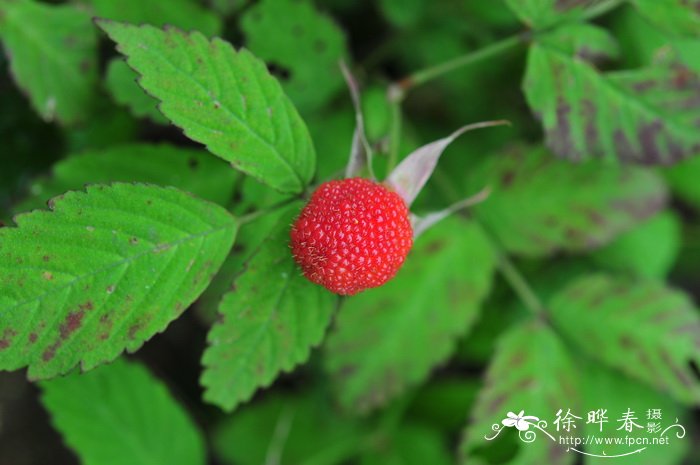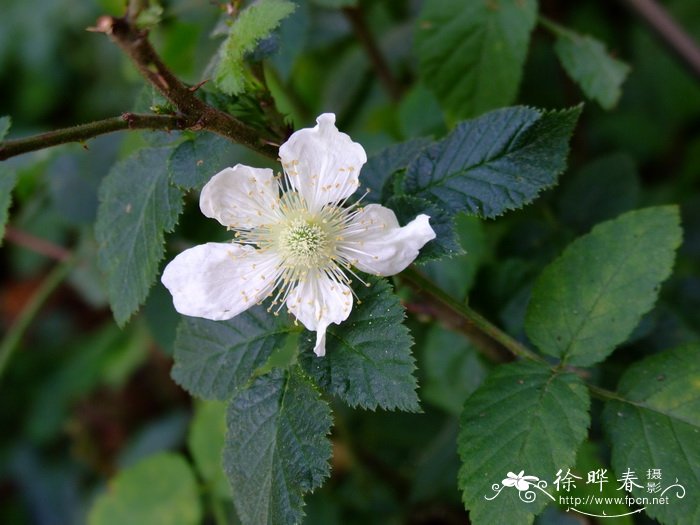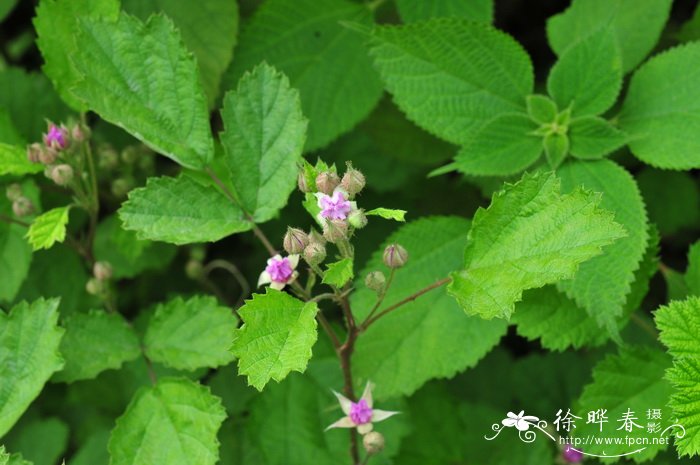茅莓Rubus parvifolius
中文名(Chinese Name):茅莓
学名(Scientific Name):Rubus parvifolius Linn.
英文名(English Common Name):
别名(Chinese Common Name):小叶悬钩子
异名(Synonym):Rubus triphyllus Thunb. Rubus parvifolius var. subconcolor (Cardot) Makino et Nemoto Rubus triphyllus var. subconcolor Cardot Rubus parvifolius var. triphyllus (Thunb.) Nakai Rubus triphyllus var. concolor subvar. subconfolor Masamune ex Kudo et Masamune Rubus hoatiensis H.L‚v.
科属(Family & Genus):蔷薇科(Rosaceae)悬钩子属
形态特征(Description):灌木,高1-2米;枝呈弓形弯曲,被柔毛和稀疏钩状皮刺;小叶3枚,在新枝上偶有5枚,菱状圆形或倒卵形,长2.5-6厘米,宽2-6厘米,顶端圆钝或急尖,基部圆形或宽楔形,上面伏生疏柔毛,下面密被灰白色绒毛,边缘有不整齐粗锯齿或缺刻状粗重锯齿,常具浅裂片;叶柄长2.5-5厘米,顶生小叶柄长1-2厘米,均被柔毛和稀疏小皮刺;托叶线形,长约5-7毫米,具柔毛。伞房花序顶生或腋生,稀顶生花序成短总状,具花数朵至多朵,被柔毛和细刺;花梗长0.5-1.5厘米,具柔毛和稀疏小皮刺;苞片线形,有柔毛;花直径约1厘米;花萼外面密被柔毛和疏密不等的针刺;萼片卵状披针形或披针形,顶端渐尖,有时条裂,在花果时均直立开展;花瓣卵圆形或长圆形,粉红至紫红色,基部具爪;雄蕊花丝白色,稍短于花瓣;子房具柔毛。果实卵球形,直径1-1.5厘米,红色,无毛或具稀疏柔毛;核有浅皱纹。花期5-6月,果期7-8月。
分布(Distribution):产东北、华东、河北、河南、山西、陕西、甘肃、湖北、湖南、江西、广东、广西、四川、贵州,生海拔400-2600米山坡杂木林下、向阳山谷、路旁或荒野。日本、朝鲜也有。
用途(Use):果实酸甜多汁,可供食用、酿酒及制醋等;根和叶含单宁,可提取栲胶;全株入药,有止痛、活血、祛风湿及解毒之效。
引自中国植物志英文版:FOC Vol. 9 Page 213
Rubus parvifolius Linnaeus, Sp. Pl. 2: 1197. 1753.
茅莓 mao mei| Rosaceae | Rubus
Shrubs 1–2 m tall, with arching branches. Branchlets grayish brown or reddish brown to blackish brown, with soft hairs and sparse, curved prickles. Leaves imparipinnate, 3–5-foliolate; petiole 2.5–5 cm, terminal leaflet 1–2 cm, petiolulate, lateral leaflets subsessile, with soft hairs and sparse, minute prickles; stipules linear, 7–10 mm, soft hairy; blade of leaflets rhombic-orbicular or obovate, 2.5–6 × 2–6 cm, abaxially densely gray tomentose, adaxially appressed-pilose, base rounded or broadly cuneate, margin unevenly coarsely serrate or coarsely incised-doubly serrate, often lobed, apex obtuse or acute. Inflorescences terminal, corymbose, rarely short racemes, 4–8 cm, several to many flowered, axillary inflorescences corymbose; rachis and pedicels pubescent, with minute prickles; bracts linear, 6–10 mm, pubescent. Pedicel 0.5–1.5 cm. Flowers ca. 1 cm in diam. Calyx abaxially densely pubescent, with unequal long needle-like prickles; sepals erect, spreading, ovate-lanceolate or lanceolate, 5–8 × 2–4 mm, apex acuminate, occasionally laciniate. Petals pink to purplish red, ovate-orbicular or oblong, 4–6 × 3–4 mm, base clawed. Stamens numerous, somewhat shorter than petals; filaments white, linear. Pistils slightly longer than or ca. as long as stamens; ovary pubescent. Aggregate fruit red, ovoid-globose, 1–1.5 cm in diam., glabrous or somewhat pubescent; pyrenes shallowly rugose. Fl May–Jun, fr. Jul–Aug. 2n = 14*, 21*, 28*.
Forests, thickets, clearings, slopes, sunny valleys, roadsides, waste places; 400--2700 m. Anhui, Fujian, Gansu, Guangdong, Guangxi, Guizhou, Hainan, Hebei, Heilongjiang, Henan, Hubei, Hunan, Jiangsu, Jiangxi, Jilin, Liaoning, Ningxia, Qinghai, Shaanxi, Shandong, Shanxi, Sichuan, Taiwan, Yunnan, Zhejiang [Japan, Korea, Vietnam].
The fruit are eaten raw and are also used for making jam, jelly, juice, syrup, candy, wine, and vinegar. The dried fruit are used in traditional Chinese medicine. The young plants are used as a substitute for tea, and the stems and roots are a source of tannin.



(责任编辑:徐晔春)
学名(Scientific Name):Rubus parvifolius Linn.
英文名(English Common Name):
别名(Chinese Common Name):小叶悬钩子
异名(Synonym):Rubus triphyllus Thunb. Rubus parvifolius var. subconcolor (Cardot) Makino et Nemoto Rubus triphyllus var. subconcolor Cardot Rubus parvifolius var. triphyllus (Thunb.) Nakai Rubus triphyllus var. concolor subvar. subconfolor Masamune ex Kudo et Masamune Rubus hoatiensis H.L‚v.
科属(Family & Genus):蔷薇科(Rosaceae)悬钩子属
形态特征(Description):灌木,高1-2米;枝呈弓形弯曲,被柔毛和稀疏钩状皮刺;小叶3枚,在新枝上偶有5枚,菱状圆形或倒卵形,长2.5-6厘米,宽2-6厘米,顶端圆钝或急尖,基部圆形或宽楔形,上面伏生疏柔毛,下面密被灰白色绒毛,边缘有不整齐粗锯齿或缺刻状粗重锯齿,常具浅裂片;叶柄长2.5-5厘米,顶生小叶柄长1-2厘米,均被柔毛和稀疏小皮刺;托叶线形,长约5-7毫米,具柔毛。伞房花序顶生或腋生,稀顶生花序成短总状,具花数朵至多朵,被柔毛和细刺;花梗长0.5-1.5厘米,具柔毛和稀疏小皮刺;苞片线形,有柔毛;花直径约1厘米;花萼外面密被柔毛和疏密不等的针刺;萼片卵状披针形或披针形,顶端渐尖,有时条裂,在花果时均直立开展;花瓣卵圆形或长圆形,粉红至紫红色,基部具爪;雄蕊花丝白色,稍短于花瓣;子房具柔毛。果实卵球形,直径1-1.5厘米,红色,无毛或具稀疏柔毛;核有浅皱纹。花期5-6月,果期7-8月。
分布(Distribution):产东北、华东、河北、河南、山西、陕西、甘肃、湖北、湖南、江西、广东、广西、四川、贵州,生海拔400-2600米山坡杂木林下、向阳山谷、路旁或荒野。日本、朝鲜也有。
用途(Use):果实酸甜多汁,可供食用、酿酒及制醋等;根和叶含单宁,可提取栲胶;全株入药,有止痛、活血、祛风湿及解毒之效。
引自中国植物志英文版:FOC Vol. 9 Page 213
Rubus parvifolius Linnaeus, Sp. Pl. 2: 1197. 1753.
茅莓 mao mei| Rosaceae | Rubus
Shrubs 1–2 m tall, with arching branches. Branchlets grayish brown or reddish brown to blackish brown, with soft hairs and sparse, curved prickles. Leaves imparipinnate, 3–5-foliolate; petiole 2.5–5 cm, terminal leaflet 1–2 cm, petiolulate, lateral leaflets subsessile, with soft hairs and sparse, minute prickles; stipules linear, 7–10 mm, soft hairy; blade of leaflets rhombic-orbicular or obovate, 2.5–6 × 2–6 cm, abaxially densely gray tomentose, adaxially appressed-pilose, base rounded or broadly cuneate, margin unevenly coarsely serrate or coarsely incised-doubly serrate, often lobed, apex obtuse or acute. Inflorescences terminal, corymbose, rarely short racemes, 4–8 cm, several to many flowered, axillary inflorescences corymbose; rachis and pedicels pubescent, with minute prickles; bracts linear, 6–10 mm, pubescent. Pedicel 0.5–1.5 cm. Flowers ca. 1 cm in diam. Calyx abaxially densely pubescent, with unequal long needle-like prickles; sepals erect, spreading, ovate-lanceolate or lanceolate, 5–8 × 2–4 mm, apex acuminate, occasionally laciniate. Petals pink to purplish red, ovate-orbicular or oblong, 4–6 × 3–4 mm, base clawed. Stamens numerous, somewhat shorter than petals; filaments white, linear. Pistils slightly longer than or ca. as long as stamens; ovary pubescent. Aggregate fruit red, ovoid-globose, 1–1.5 cm in diam., glabrous or somewhat pubescent; pyrenes shallowly rugose. Fl May–Jun, fr. Jul–Aug. 2n = 14*, 21*, 28*.
Forests, thickets, clearings, slopes, sunny valleys, roadsides, waste places; 400--2700 m. Anhui, Fujian, Gansu, Guangdong, Guangxi, Guizhou, Hainan, Hebei, Heilongjiang, Henan, Hubei, Hunan, Jiangsu, Jiangxi, Jilin, Liaoning, Ningxia, Qinghai, Shaanxi, Shandong, Shanxi, Sichuan, Taiwan, Yunnan, Zhejiang [Japan, Korea, Vietnam].
The fruit are eaten raw and are also used for making jam, jelly, juice, syrup, candy, wine, and vinegar. The dried fruit are used in traditional Chinese medicine. The young plants are used as a substitute for tea, and the stems and roots are a source of tannin.
(责任编辑:徐晔春)
踩一下[0]

顶一下[4]